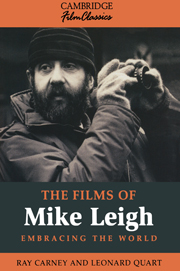Book contents
- Frontmatter
- Contents
- Editorial Note
- Acknowledgments
- Biographical and Cultural Introduction
- 1 Stylistic Introduction: Living beyond Consciousness
- 2 Fictitious Selves: Bleak Moments
- 3 Personal Freezing and Stylistic Melting: Hard Labour
- 4 Existence without Essences: The Kiss of Death
- 5 Defeating Systems of Knowing: Nuts in May
- 6 Losing Track of Who You Are: Abigail's Party
- 7 We Are the Hollow Men: Who's Who
- 8 Inhabiting Otherness: Grown-Ups
- 9 Manufactured Emotions: Home Sweet Home
- 10 Challenging Easy Understandings: Meantime
- 11 Holding Experience Loosely: High Hopes
- 12 Circulation Is the Law of Life: Life Is Sweet
- 13 Desperate Lives: Naked
- Epilogue: The Feel of Life
- Notes
- Filmography
- Bibliography
- Index
7 - We Are the Hollow Men: Who's Who
Published online by Cambridge University Press: 05 June 2012
- Frontmatter
- Contents
- Editorial Note
- Acknowledgments
- Biographical and Cultural Introduction
- 1 Stylistic Introduction: Living beyond Consciousness
- 2 Fictitious Selves: Bleak Moments
- 3 Personal Freezing and Stylistic Melting: Hard Labour
- 4 Existence without Essences: The Kiss of Death
- 5 Defeating Systems of Knowing: Nuts in May
- 6 Losing Track of Who You Are: Abigail's Party
- 7 We Are the Hollow Men: Who's Who
- 8 Inhabiting Otherness: Grown-Ups
- 9 Manufactured Emotions: Home Sweet Home
- 10 Challenging Easy Understandings: Meantime
- 11 Holding Experience Loosely: High Hopes
- 12 Circulation Is the Law of Life: Life Is Sweet
- 13 Desperate Lives: Naked
- Epilogue: The Feel of Life
- Notes
- Filmography
- Bibliography
- Index
Summary
“I'll also sort of spend time doodling on a page, where you sort of go – and this is very private. I don't show this to anybody. …” Leigh now removes a cocktail napkin from his coat pocket and begins to draw something resembling a family tree. He writes down the names of all of the major characters from the film, connecting them with various lines and symbols, taking time out to remind me that this may seem somewhat simplistic only because he is basing it on a finished film and not one in development: “You see, people say to me, ‘Do you know the story [when you begin]? Do you know the end? Do you know the narrative?’ The answers to those questions are no, no, and no. But those of us who know about filmmaking and conception know that there's a difference between a view of the linear construction of the narrative and the dynamics of the play – which is what that drawing is. This is a way of visualizing the potential film, and by thinking that through, you give yourself a structure in which you then start thinking of what it means thematically, what you're trying to say here.”
–Scott FoundrasLeigh's work is seldom appreciated as being as artistically advanced as it actually is. Perhaps that is because his narratives pass for simple “realism,” or because most critics tend to identify cinematic sophistication with particular formal mannerisms – virtuosic camera movements, visual and acoustic sublimities, spatial dislocations, abrogations of chronological presentation – to which Leigh is averse.
- Type
- Chapter
- Information
- The Films of Mike Leigh , pp. 116 - 129Publisher: Cambridge University PressPrint publication year: 2000



